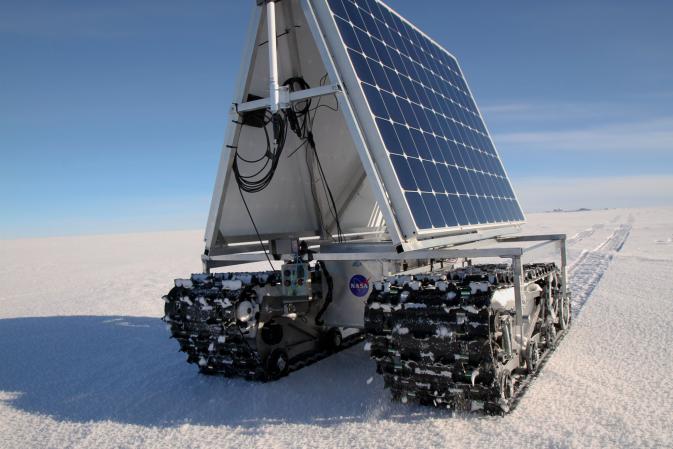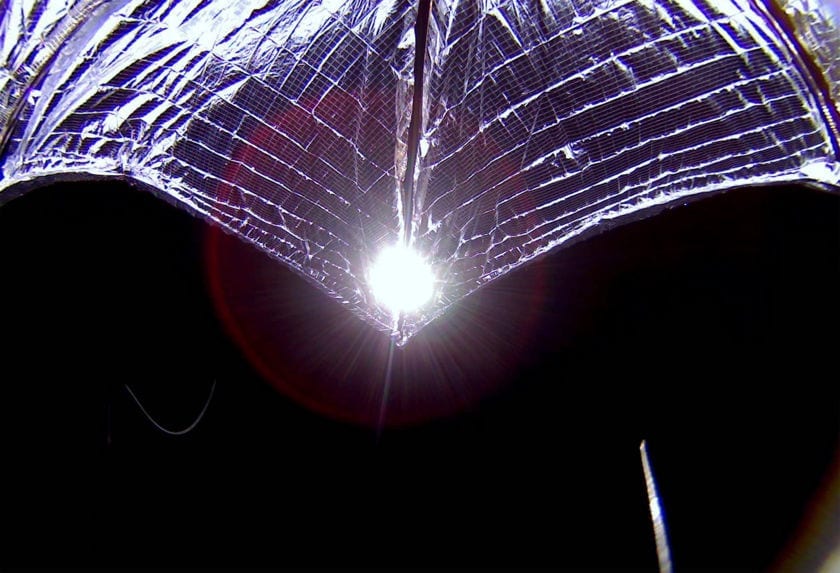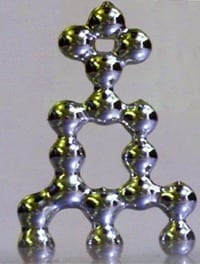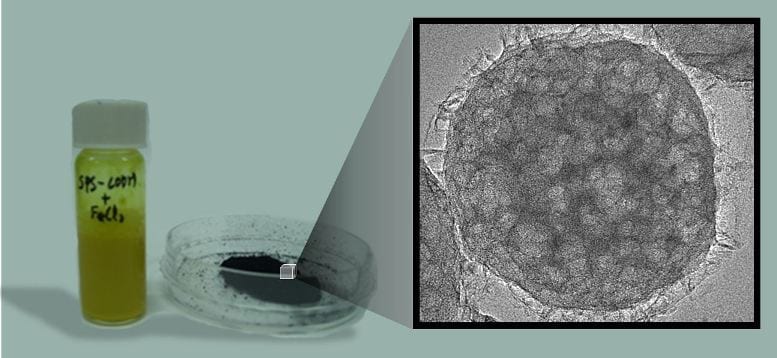
Defying 30 mph gusts and temperatures down to minus 22 F, NASA’s new polar rover recently demonstrated in Greenland that it could operate completely autonomously in one of Earth’s harshest environments.
The robot known as GROVER, which stands for both Greenland Rover and Goddard Remotely Operated Vehicle for Exploration and Research, was designed by teams of students attending engineering boot camps at Goddard in the summers of 2010 and 2011. Built to carry a ground-penetrating radar to analyze layers of snow and ice, the rover was later transferred to Boise State University for fine-tuning with NASA funding.
Although researchers had tested GROVER at a beach in Maryland and in the snow in Idaho, the May 6 to June 8 testing at Summit Camp, the highest spot in Greenland, was the rover’s first polar experience. One of the main goals was proving that the robot could execute commands sent from afar over an Iridium satellite connection – an objective GROVER accomplished.
“When we saw it moving and travelling to the locations our professor had keyed in from Boise, we knew all of our hard work had paid off,” said Gabriel Trisca, a graduate student from Boise State University who has been involved in the GROVER project from its start. “GROVER has grown to be a fully-autonomous, GPS-guided and satellite-linked platform for scientific research.” Trisca accompanied the robot to Greenland.
GROVER collected and stored radar data over 18 miles during the five weeks it spent on the ice. During the testing, the rover was also able to transmit information in real time on how its onboard systems were performing. The robot’s solar-charged batteries allowed it to operate for up to 12 hours before having to recharge.
“When you work at the poles, on the ice, it’s cold, it’s tiring, it’s expensive and there’s a limit to how much ground you can cover on snowmobiles,” said Lora Koenig, a glaciologist at NASA’s Goddard Space Flight Center in Greenbelt, Md. “It would be great if autonomous robotic platforms could do part of this work — especially the part where high winds and blowing snow try to freeze your skin.”
Though researchers had initially expected the 800-pound robot to work around the clock and cover more ground, the extreme polar conditions took a toll on GROVER’s electronics, battery consumption and mobility.
“This is very common the first time you take an instrument into an environment like Greenland,” said Hans-Peter Marshall, a geoscientist at Boise State University and science adviser on the project. “It’s always more challenging than you thought it was going to be: Batteries don’t recharge as fast and they don’t last as long, and it takes computers and instrumentation longer to boot.”
Another challenge was the uneven icy terrain. The researchers had to repeatedly tinker with the rover’s speed and the power sent to each of its two autonomous tracks so that the robot would not get stuck in the snow.
The Latest Bing News on:
GROVER
- Riya Sharma on Dhruv Tara, her bond with Ishaan Dhawan & her fav character & Karan V Groveron May 8, 2024 at 3:25 pm
During the conversation, she discussed her favorite sweet dish, her skincare routine for summers, her favorite character on the show, and her bond with co-stars Ishaan Dhawan and Karan V Grover. Riya ...
- Grover Cleveland Didn’t Lie About His Sex Scandalon May 8, 2024 at 11:50 am
Cleveland, unlike Trump, was unmarried. He’d never been divorced. And the closest thing he had to a sex scandal before his presidential nomination was a bunch of stories about jolly drinking parties ...
- The Great Indian Kapil Show: Archana Puran Singh, Sunil Grover and others share SHOCKING update about the showon May 8, 2024 at 5:14 am
T he first season of The Great Indian Kapil Show on Netflix has been making waves with its recent conclusion. There were rumors that the ending was sudden for such a popular show, ...
- The Great Indian Kapil Show: Kapil Sharma’s salary is 20 times more than Sunil Grover’s – Check out how much others are charging for the Netflix showon May 8, 2024 at 3:30 am
At the helm of the show is Kapil Sharma, India's wealthiest TV actor, commanding an impressive paycheck of Rs 26 crore for the first five episodes.
- Garcetti, Magic and Grover Set to Participate at Milken Global Conferenceon May 7, 2024 at 6:27 am
Former Los Angeles Mayor Eric Garcetti will be among Tuesday’s participants at the Milken Institute’s 27th annual Global Conference in Beverly Hills, along with former House Speaker Kevin McCarthy, ...
- Kapil Sharma being paid Rs 26 crore for five episodes of Netflix's 'The Great Indian Kapil Show', Sunil Grover taking home…on May 5, 2024 at 9:26 pm
After a long spat, Kapil Sharma and Sunil Grover reunited for Netflix’s The Great Indian Kapil Show. Their camaraderie won the audience’s hearts in the show’s latest episode, which Aamir Khan graced.
- Grover Voucher Codeson May 5, 2024 at 6:30 am
Molly Higgins is a product/content reviewer and contributing producer at WIRED. She graduated with a bachelor’s degree in English from UCLA and an MFA in creative nonfiction writing from the ...
- Exclusive: "I want to leave a lasting impact," says Varun Groveron May 5, 2024 at 1:32 am
Wordsmith Varun Grover recently turned director with All India Rank. He takes Suman Sharma through the transition. Read: ...
- Grover Beach man arrested during search warranton May 1, 2024 at 4:16 pm
Grover Beach Police arrested a man during a search warrant of a Grover Beach home. On Monday, police say they located a stolen vehicle at a home on the 1600 block of Brighton Avenue. Officers served a ...
- 'They have nothing!': Macon man says house fire devastated his family after recently losing a family memberon April 30, 2024 at 9:03 pm
MACON, Ga. — A fire took away more than just four walls to call home for the Grover family. They're also mourning the memories made and the irreplaceable items that remind them of their mother. Their ...
The Latest Google Headlines on:
GROVER
[google_news title=”” keyword=”GROVER” num_posts=”10″ blurb_length=”0″ show_thumb=”left”]
The Latest Bing News on:
Polar rover
- Photo reveals ‘secret robot’ attached to China’s Moon rocket that was NOT disclosed before launchon May 8, 2024 at 4:43 am
CHINA may have snuck a secret mini-rover onto the Chang’e-6 lunar rocket that is currently on its way to the far side of the Moon, new images reveal. The Chang’e-6 mission was supposed ...
- 'A habitable environment': NASA's Curiosity rover data reveals Earth-like condition on ancient Marson May 2, 2024 at 12:33 am
Researchers utilizing NASA's Curiosity rover's ChemCam instrument unveiled elevated manganese levels in lakebed rocks within Mars' Gale Crater, suggesting a potential Earth-like environment ...
- NASA's Viper moon rover gets its 'neck' and 'head' installed for mission later this yearon April 29, 2024 at 2:00 pm
With its "mighty mast," NASA's Polar Exploration Rover dubbed VIPER continues to be prepped for its mission to the moon slated for late 2024.
- A rover captures images of 'spiders' on Mars in Inca City. But what is it, really?on April 26, 2024 at 5:09 am
A rover captured signs of clustered dark dots on Mars' Inca City that resemble spiders, which formed due to seasonal eruptions of carbon dioxide gas.
- NASA’s Artemis Astronauts Will Help Grow Crops on the Moon—And Much Moreon April 16, 2024 at 5:01 pm
Robots will still assist the effort, however: LDA’s siting will be indirectly supported by NASA’s Volatiles Investigating Polar Exploration Rover, or VIPER, which will sniff out water ...
- NASA's VIPER moon rover gets its head and neckon April 15, 2024 at 5:00 pm
In this image from Feb. 12, 2024, engineers lift a mast into place on NASA's VIPER (Volatiles Investigating Polar Exploration Rover) robotic moon rover. VIPER's mast and the suite of instruments ...
- Astrobotic to launch mini rover along with NASA's ice-hunting VIPER on next moon missionon April 8, 2024 at 5:00 pm
Griffin's main job is to deliver NASA's ice-hunting VIPER rover to the lunar south polar region, but we learned on Monday (April 8) that the lander will tote another, smaller rover as well.
- Comprehensive Update: NASA’s VIPER Rover Prepares for Lunar Exploration with Mast Elevationon April 1, 2024 at 9:42 am
NASA is advancing its lunar exploration capabilities with the Volatiles Investigating Polar Exploration Rover, known as VIPER. The rover recently achieved a significant milestone by raising its ...
- 31st Polar Bear Plunge at Seaside Heightson February 24, 2024 at 4:01 pm
More than 8,000 people participated in the 31st Polar Bear Plunge at Seaside Heights on Saturday, February 24, 2024.Get Photo More than 8,000 people participated in the 31st Polar Bear Plunge at ...
The Latest Google Headlines on:
Polar rover
[google_news title=”” keyword=”polar rover” num_posts=”10″ blurb_length=”0″ show_thumb=”left”]











